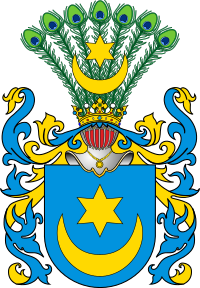
The House of Tarnowski (plural: Tarnowscy) is the name of a Polish noble and aristocratic family ( szlachta ). Because Polish adjectives have different forms for the genders, Tarnowska is the form for a female family member. [1]

The House of Tarnowski (plural: Tarnowscy) is the name of a Polish noble and aristocratic family ( szlachta ). Because Polish adjectives have different forms for the genders, Tarnowska is the form for a female family member. [1]


The Tarnowski family was one of the oldest and most powerful magnate families in Poland. It reached its apex in the 14th, 15th and the 16th centuries, when members of the Tarnów, Melsztyn and later Jarosław branches held prominent positions beside the Piast and Jagiellon kings of Poland. From father to son, the Tarnowski family held ten times the office of voivode of Kraków Voivodeship and six times the office of castellan of Kraków.
The history of the family started with the trusted advisor of the last Piast kings Comes Spytek z Melsztyna, the progenitor of the Tarnowski-Melsztyński-Jarosławski family. By 1320 he held the office of voivode of Kraków, and from 1331 the highest secular office in the Kingdom of Poland, castellan of Kraków. For his military service, King Władysław I the Elbow-high gave him large estates on the Dunajec river, where Spytek founded the city of Tarnow in 1330 and built two stronghold castles in Tarnow and Melsztyn around 1340.
After the death of Spytek, the castle of Melsztyn was inherited by his son Jan z Melsztyna, who like his father was from 1360 voivode and castellan of Kraków. His younger brother, the castellan of Wiślica Rafał z Tarnowa, became the owner of Tarnow. Rafał expanded his estates, adding land in Sandomierz, Wielowieś and Dzików.





The son of Jan z Melsztyna, Spytek z Melsztyna, was the next owner of Melsztyn. He was voivode of Kraków, Feudal Lord of Podolia, and hero of the 1399 battle of Worskla. Rafał's son Jan z Tarnowa was appointed General Starost of Ruthenia, and both voivode and castellan of Kraków.
The Tarnowski-Melsztyński family achieved the highest offices in the country as well as extraordinary wealth and huge feudal estates, including land in Jarosław, Sambor, Podole, etc. Their most significant role in the history of Poland was to organise the union of Queen Jadwiga and Władysław II Jagiełło and to initiate their coronation.
After the death of Spytek z Melsztyna and the death of his son, who was also named Spytek z Melsztyna, in the 1439 battle of Grotniki, the Melsztyn line declined. In the Tarnów line, the sons of Jan z Tarnowa fought in the Battle of Grunwald in 1410 and after that divided the family property. Jan the voivode of Kraków Voivodeship settled in Tarnów, and the voivode of Sandomierz Voivodeship Spytek became the owner of Jarosław, where he started a new branch of the family, called the "Leliwita branch".
Jan z Tarnowa had five sons, of which Jan Amor Starszy Tarnowski and Jan Gratus Tarnowski together with their cousin, Spytek z Jarosławia, died with King Władysław III of Poland in the 1444 Battle of Varna. His third son Jan Rafał Tarnowski became a priest and the last two, Jan Feliks Tarnowski became voivode of Lublin Voivodeship, while Jan Amor Młodszy Tarnowski inherited Tarnów and was appointed voivode of Kraków, and in 1490 castellan of Kraków.
The son of Jan Amor Młodszy, Jan Amor Tarnowski, became Great Crown Hetman, voivode of Kraków and castellan of Kraków. In 1540 he built a castle and founded the city of Tarnopol (1548).
The Tarnowski family used the "Leliwa coat of arms" and their motto was: "Tendite ad astra viri". It is a quotation from Valerius Flaccus' Argonautica, book I, verse 563.

Some of the prominent residences of the Tarnowski family are:

Tarnów is a city in southeastern Poland with 105,922 inhabitants and a metropolitan area population of 269,000 inhabitants. The city is situated in the Lesser Poland Voivodeship. It is a major rail junction, located on the strategic east–west connection from Lviv to Kraków, and two additional lines, one of which links the city with the Slovak border.
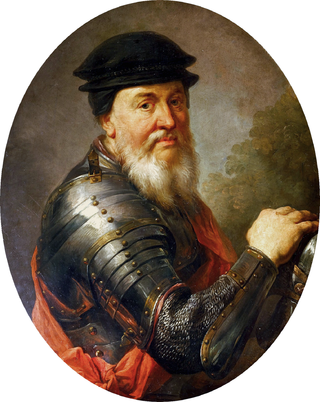
Jan Amor Tarnowski was a Polish nobleman, knight, military commander, military theoretician, and statesman of the Crown of the Kingdom of Poland. He was Grand Crown Hetman from 1527, and was the founder of the city of Tarnopol, where he built the Ternopil Castle and the Ternopil Pond. The first Count of the Holy Roman Empire in the Tarnowski family (1547).

Sandomierz Voivodeship was a unit of administration and local government in Poland from the 14th century to the partitions of Poland in 1772–1795. It was part of the Lesser Poland region and the Lesser Poland Province. Originally Sandomierz Voivodeship also covered the area around Lublin, but in 1474 its three eastern counties were organized into Lublin Voivodeship. In the 16th century, it had 374 parishes, 100 towns and 2586 villages. The voivodeship was based on the Sandomierz ziemia, which earlier was the Duchy of Sandomierz. The Duchy of Sandomierz was created in 1138 by King Bolesław III Wrymouth, who in his testament divided Poland into five principalities. One of them, with the capital at Sandomierz, was assigned to Krzywousty's son, Henry of Sandomierz. Later on, with southern part of the Seniorate Province, the Duchy of Sandomierz created Lesser Poland, divided into Kraków and Sandomierz Voivodeships.

Zofia Odrowąż (1537–1580) was a Polish noblewoman.
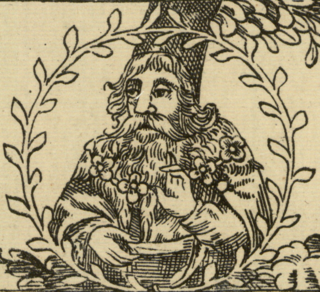
Rafał of Tarnów was a Polish nobleman (szlachcic)

Spytek of Melsztyn was a Polish nobleman (szlachcic) of the Leliwa coat of arms.

Spytek of Melsztyn, also known as Spytko, was a member of the Polish nobility and a strong supporter of Polish cooperation with the Hussite movement.
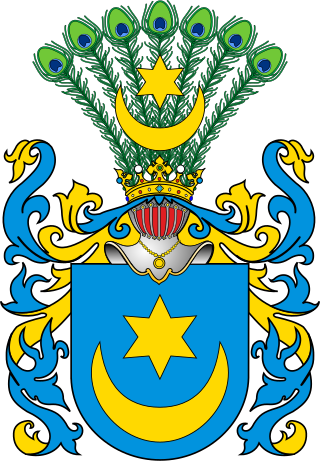
Jan of Tarnów was a Polish nobleman (szlachcic) from the Lesser Poland region.
Spytek of Tarnów and Jarosław was a Polish nobleman (szlachcic).
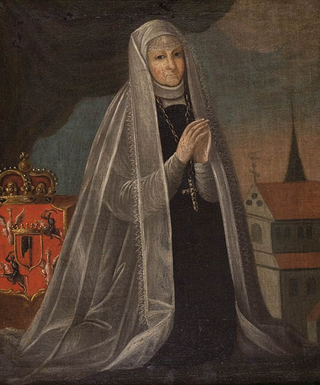
Elizabeth Granowska or Elisabeth Pilecki was Queen of Poland (1417–1420) as the third wife of Władysław II Jagiełło (Jogaila), Grand Duke of Lithuania and King of Poland.
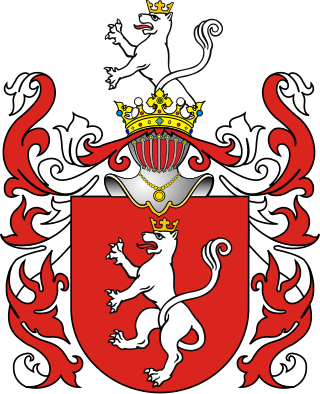
Firlej was a Polish szlachta (nobility) family. Magnates in the 15th and 17th century.

The Kraków Voivodeship was a voivodeship (province) in the Kingdom of Poland from the 14th century to the partition of Poland in 1795. Located in the southwestern corner of the country, it was part of the Lesser Poland region and the Lesser Poland Province.
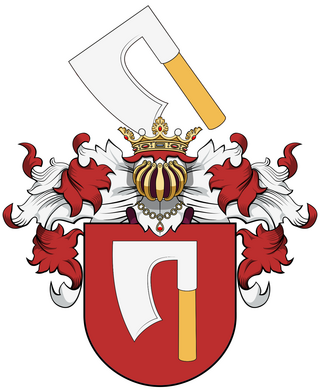
The House of Tęczyński was a powerful family of nobility (szlachta) in the Kingdom of Poland, during the times of the late Piast dynasty, the Jagiellon dynasty and in the early decades of the Polish–Lithuanian Commonwealth. They were an important family from Lesser Poland (Małopolska), active in Polish politics of their time.

Bernard of Niemodlin, was a Duke of Strzelce and Niemodlin during 1382–1400, Duke of Opole during 1396–1400, from 1400 until 1450 sole ruler over Strzelce and Niemodlin, from 1401 ruler over Olesno and Lubliniec, from 1420 ruler over Prudnik and in 1424 ruler over Głogówek, during 1434–1450 ruler over Kluczbork and Byczyna and from 1450 ruler over only Olesno.

Zborowski of the Jastrzębiec coat of arms was a Polish noble family from Greater Poland, It played a significant role in Polish politics in the 16th century.
The Dunajec river castles is a chain of thirteen medieval castles, built in southern Lesser Poland, along the Dunajec river. The castles protected the border between the Kingdom of Poland and the Kingdom of Hungary, as well as a very important international trade route, which went along the Dunajec and the Poprad all the way down to the Danube river. Most of the castles are in ruins now, and some have disappeared. Their history dates back to the period known as the Fragmentation of Poland in the early 12th century, when, according to his will, known as the Testament of Bolesław III Wrymouth, the country was divided into several provinces. The Dunajec river castles were located on the territory of two castellanies, Wojnicz and Nowy Sącz, in the extreme south of the Seniorate Province.
Spycimir, also Spyćmier, Spyćmir, Spyćmierz, Spićymierz, etc., is an old Polish masculine given name. Etymology: spyci-: "in vain", -mir: "peace". Diminutives: Spytko, Spytek. Its name day is 26 April.